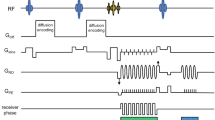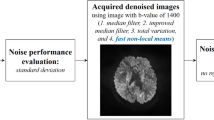Abstract
Objective
To investigate the optimal monochromatic color combination for fusion imaging of FDG-PET and diffusion-weighted MR images (DW) regarding lesion conspicuity of each image.
Methods
Six linear monochromatic color-maps of red, blue, green, cyan, magenta, and yellow were assigned to each of the FDG-PET and DW images. Total perceptual color differences of the lesions were calculated based on the lightness and chromaticity measured with the photometer. Visual lesion conspicuity was also compared among the PET-only, DW-only and PET-DW-double positive portions with mean conspicuity scores. Statistical analysis was performed with a one-way analysis of variance and Spearman’s rank correlation coefficient.
Results
Among all the 12 possible monochromatic color-map combinations, the 3 combinations of red/cyan, magenta/green, and red/green produced the highest conspicuity scores. Total color differences between PET-positive and double-positive portions correlated with conspicuity scores (ρ = 0.2933, p < 0.005). Lightness differences showed a significant negative correlation with conspicuity scores between the PET-only and DWI-only positive portions. Chromaticity differences showed a marginally significant correlation with conspicuity scores between DWI-positive and double-positive portions.
Conclusions
Monochromatic color combinations can facilitate the visual evaluation of FDG-uptake and diffusivity as well as registration accuracy on the FDG-PET/DW fusion images, when red- and green-colored elements are assigned to FDG-PET and DW images, respectively.





Similar content being viewed by others
References
Nagamachi S, Nishii R, Wakamatsu H, et al. The usefulness of 18F-FDG PET/MRI fusion image in diagnosing pancreatic tumor: comparison with 18F-FDG PET/CT. Ann Nucl Med. 2013;27:554–63.
Kitajima K, Suenaga Y, Ueno Y, et al. Fusion of PET and MRI for staging of uterine cervical cancer: comparison with contrast-enhanced 18F-FDG PET/CT and pelvic MRI. Clin Imaging. 2014;38:464–9.
Heusch P, Nensa F, Schaarschmidt B, et al. Diagnostic accuracy of whole-body PET/MRI and whole-body PET/CT for TNM staging in oncology. Eur J Nucl Med Mol Imaging. 2015;42:42–8.
Kanda T, Kitajima K, Suenaga Y, et al. Value of retrospective image fusion of 18F-FDG PET and MRI for preoperative staging of head and neck cancer: comparison with PET/CT and contrast-enhanced neck MRI. Eur J Radiol. 2013;82:2005–10.
Heusch P, Sproll C, Buchbender C, et al. Diagnostic accuracy of ultrasound, 18F-FDG-PET/CT, and fused 18F-FDG-PET-MR images with DWI for the detection of cervical lymph node metastases of HNSCC. Clin Oral Investig. 2014;18:969–78.
Schmidt H, Brendle C, Schraml C, et al. Correlation of simultaneously acquired diffusion-weighted imaging and 2-deoxy-[18F] fluoro-2-d-glucose positron emission tomography of pulmonary lesions in a dedicated whole-body magnetic resonance/positron emission tomography system. Investig Radiol. 2013;48:247–55.
Park H-H, Kim SY, Cho A, et al. (2007) The value of fusion imaging with FDG-PET and DWI MR in ovarian lesions. J Nucl Med Meet Abstr 48:457.
Valdés Hernández MdC, Ferguson KJ, Chappell FM, Wardlaw JM. New multispectral MRI data fusion technique for white matter lesion segmentation: method and comparison with thresholding in FLAIR images. Eur Radiol. 2010;20:1684–91.
Phillips WE 2nd, Brown HK, Bouza J, Figueroa RE. Neuroradiologic MR applications with multiparametric color composite display. Magn Reson Imaging. 1996;14:59–72.
Alfano B, Brunetti A, Ciarmiello A, Salvatore M. Simultaneous display of multiple MR parameters with “quantitative magnetic color imaging”. J Comput Assist Tomogr. 1992;16:634–40.
Robertson AR. Historical development of CIE recommended color difference equations. Color Res Appl. 1990;15:167–70.
Zhu YM, Nortmann CA. Pixel-feature hybrid fusion for PET/CT images. J Digit Imaging. 2011;24:50–7.
Park H, Wood D, Hussain H, et al. Introducing parametric fusion PET/MRI of primary prostate cancer. J Nucl Med. 2012;53:546–51.
Acknowledgements
We thank Mr. Eiji Myokan and Mr. Koji Kawano at EIZO Corporation for their support measuring lightness and chromaticity using the CS-1000A spectrophotometer.
Author information
Authors and Affiliations
Corresponding author
Appendix
Appendix
The Yxy system and CIE L*a*b* (CIELAB) system proposed by the International Commission on Illumination (CIE, Vienna, Austria) [11] were adopted in this analysis. The Yxy system is a widely used method to specify colors, where the parameter Y indicates the lightness of a color, and the chromaticity of a color is specified by the remaining two parameters x and y. CIELAB is a complete color space that describes all the colors that the human eye perceives. The three coordinates of CIELAB stand for the lightness of a color (L*), its position between red/magenta and green (a*), and its position between yellow/blue (b*).
The calculation of color differences requires the conversion of Yxy values to L*a*b* values. This can be done with a white reference point, which is the maximum white level on the monitor of interest. The color difference indicated by the Euclidean distance between the two colors in CIELAB space is known as the CIE 1976 formula. The mathematical details are as follows.
First, the measured Yxy values are converted into XYZ values.
L*a*b* values are calculated according to the following equations:
where Xn, Yn, and Zn are the values of X, Y, and Z for the appropriate white reference value.
Finally, color differences are computed with the following equations.
Total color difference:
The chromaticity difference is the color difference after accounting for lightness differences.
Rights and permissions
About this article
Cite this article
Kamei, R., Watanabe, Y., Sagiyama, K. et al. Optimal monochromatic color combinations for fusion imaging of FDG-PET and diffusion-weighted MR images. Ann Nucl Med 32, 437–445 (2018). https://doi.org/10.1007/s12149-018-1263-y
Received:
Accepted:
Published:
Issue Date:
DOI: https://doi.org/10.1007/s12149-018-1263-y




